What is a Motherboard : A Computer Motherboard is commonly known as the Main board or MB or System board or logic board that is designed on PCB (Printed Circuit Board).
The motherboard holds or connects all components and parts on a single sheet.
The Computer Motherboard holds all the circuitry to connect the various components of a computer system.
Therefore it is also called the backbone of the Personal computer system.
The Mainboard or Motherboard is the main, crucial, and important part of the computer system.
It holds many important components such as Computer memory slots, CPU, SATA IDE slots, expansion slots(PCI, AGP, etc), capacitors, resistors, BIOS chip, etc.
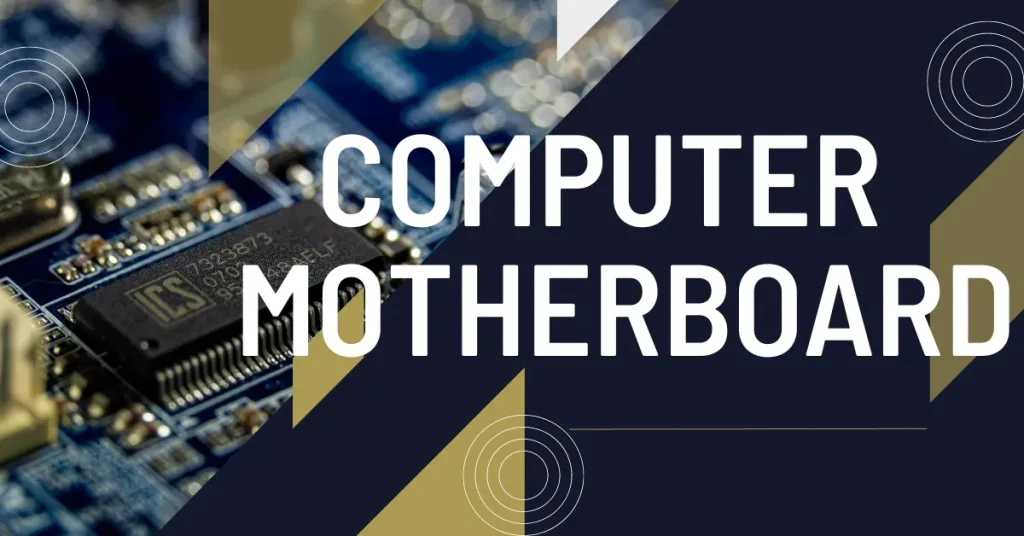
The Computer mainboard is made up of a thin sheet of non-conductive material from plastic. The traces which are present on the motherboard is made up of copper/aluminum foil.
There are many companies that manufacture an excellent quality of logic boards these days such as Intel, Asus, Gigabyte, MSI, ASRock, Sapphire technology, Biostar, etc.
People Are Also Reading
- What are Different Types of Motherboard
- Motherboard Form Factors
- How to Identify What Motherboard Do I Have
Computer Motherboard Label Diagram
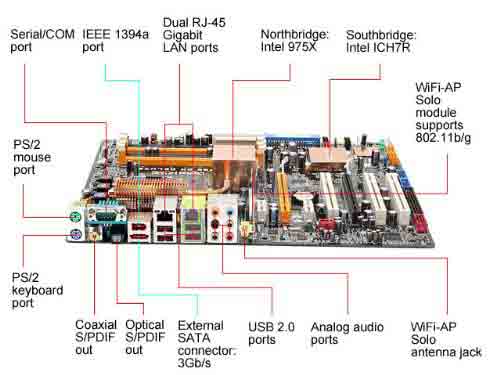
Components and Parts Used in Computer Motherboard
There are various components embedded in MB/PCB (Printed Circuit Board).
You should know the basic computer functionality and uses of the various component attached to the mainboard to use and install in the Computer case.
Today Computer Motherboards come in several varieties but the basic functionality and uses are pretty much the same.
You must be familiar with the use and aware of the basic architecture of PC and Laptop motherboard design
As it is difficult to understand every part of MB still you should be aware of some common and important components & parts attached to it.
Useful Video On: What is a Motherboard in a Computer System
List of Components Used in Computer Motherboard
- Expansion slots (PCI Express, PCI, and AGP)
- 3-pin case fan connectors
- Back panel connectors
- Heat sink
- 4-Pin (P4) power connector
- CPU Socket
- Screw hole
- Memory slot
- Floppy connection
- ATA (IDE) disk drive primary connection
- 24-pin ATX power supply connector
- Serial ATA connections
- Coin cell battery (CMOS backup battery)
- System panel connectors
- Serial port connector
- USB headers
- Jumpers
- SPDIF
- Game port and MIDI header
- Internal speaker
- Keyboard controller
- Parallel port header
- PS/2 header
People Are Also Reading
- What is Computer Fundamentals
- Advantages and Disadvantages of Computer
- Block Diagram of Computer
- Characteristics of Computer
- Classifications of Computer System
Computer Motherboard Components and Their Features
| Component | Features |
 | · Ps/2 Mouse Connector. · Circular In Shape. · 6 Pins. · Female Type of Connector. · Usually Green In color. |
 | 1. PS/2 Keyboard Connector. 2. Circular In Shape. 3. 6 Pins. 4. Female Type of Connector. 5. Usually, Violet in Color. |
 | 1. Serial / Normal Mouse Connector. 2. D-Shape Connector. 3. 9 Pins. 4. Male Type Connector. |
 | 1. Display /VGA Port. 2. D -Type of Connector. 3. 15 Pins. 4. Female Type of Connector. 5. Usually Blue in Color. |
 | 1. USB Stands for Universal Serial Bus. 2. You can connect any USB Device to this connector. 3. Ex: Pen drive, Scanner, Printer, Card reader. 4. The motherboard may contain more than 2 USB Slots. |
 | 1. Used to Access the Internet. 2. RJ-45 Patch cable Is connected. 3. Used for Networking. |
 | 1. There Are 3 Slots Mainly in Sound Port. 2. 1st Is Light Blue (Input Audio). 3. Middle is Light Green (Output Audio). 4. Last One is Light Pink (Mike). |
| 1. Parallel Port (LPT1, Line Printer, Printer Port). 2. Serial-Printer is Connected to this Port. 3. 25 Pin. 4. Female-Type Connector. 5. D-Shape Connector | |
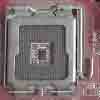 | 1. This is a CPU socket where the processor is Installed. |
 | 1. Ram is connected to this Slot. 2. Slots are mainly named (DIMM, and SIMM). 3. DIMM Stands for (Dual inline memory module). 4. SIMM (Single inline memory module). |
 | 1. SATA (Serial Advanced Technology Attachment). 2. You can attach SATA (Hard Disk ), and SATA (DVD -RW). |
| 1. Floppy Disk Drive is out of date, nobody uses this device nowadays. 2. 34 Pin. 3. Male Connector | |
| 1. IDE (Integrated Device Electronics). 2. 40 Pins Connector. | |
 | 1. There are 3 types of SMPS power connectors (12 Pins,20 Pins, and 24 Pins). 2. SMPS Power Supply is connected here. 3. It gives desired voltages to the motherboard and converts AC volts into DC |
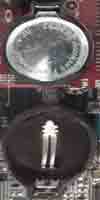 | 1. Here CMOS Battery is Inserted |
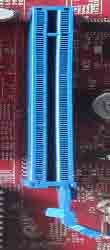 | 1. AGP (Advanced Graphic Port). 2. Graphic card is connected to this slot |
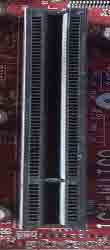 | 1. PCI (Peripheral Component Interconnect) 2. You can connect a display card, sound card, and LAN card to this slot |
 | 1. Processor fan is connected here |
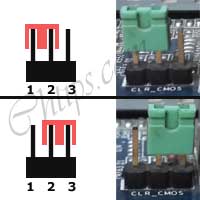 | 1. This jumper is used to clear all Bios settings. |
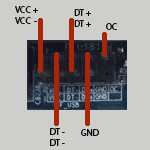 | 1. Ground +, Ground – 2. DT+ ,DT+ 3. DT-, DT- 4. VCC+,VCC- |
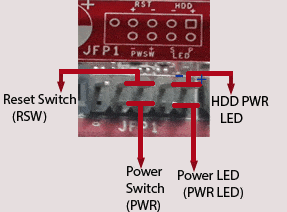 | 1. Power Switch 2. Reset Switch 3. HDD Led 4. Power led |
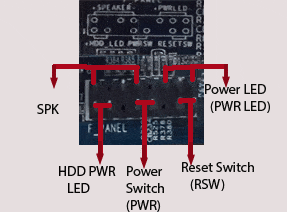 | 1. Power Switch 2. Reset Switch 3. HDD Led 4. Power Led |
 | 1. You Can Insert Your Audio Pin In the front side of the computer case to hear a sound |
You May Also Like
- The Five Generations of Computer
- A Brief History of Computer
- Input Devices of Computer System
- Output Devices of Computer System
- Different Types of Computer
- Computer Basic Tutorials
Complete Description & Definition of Computer Motherboard
The desktop or PC motherboard is mounted inside the computer case with the help of small screws which are used to tighten the system board into the computer case.
The computer case possesses some pre-drilled holes so that the screws can be easily fit into it.
The system or Mainboard consists of a single CPU socket that is pre-soldered into it.
Various types of CPU sockets are used to determine the computer motherboard and the CPU that is compatible with it.
You can determine which processor is compatible or suited to the motherboard as there is a number printed on the CPU socket which determines which CPU to be installed on it.
There are memory slots commonly called DIMM or SIMM which allow users to install memory (RAM) into them.
The number of memory slots depends entirely upon the manufacturer of the motherboard.
Expansion slots are used in the motherboard so that you can install additional video cards, sound cards, and graphic cards into it.
These expansion slots are pre-install. Some of the expansion slots are:: PCI, AGP, ISA, etc
Front panel connectors on motherboards have a Power switch, Reset, power LED, and HDD led connectors which are connected by wires.
Jumpers are used for specific purposes such as CMOS clear jumper is used to reset bios password.
On the left side of the motherboard, there are number of ports that are used to connect to other peripherals of computer system such as monitors, USB drives, printers, keyboard, mouse, LAN , modem etc.
There is a small coin-shaped cell commonly called a CMOS battery which is inserted into a battery connector present on the motherboard.
SATA and IDE slots are available to connect to other devices such as hard drives and DVD-RW with the help of cables.
24 pins power connector is available to connect the power supply(SMPS) and an additional 4 pins p4 power connector is also available.
What are the 3 Functions of Motherboard?
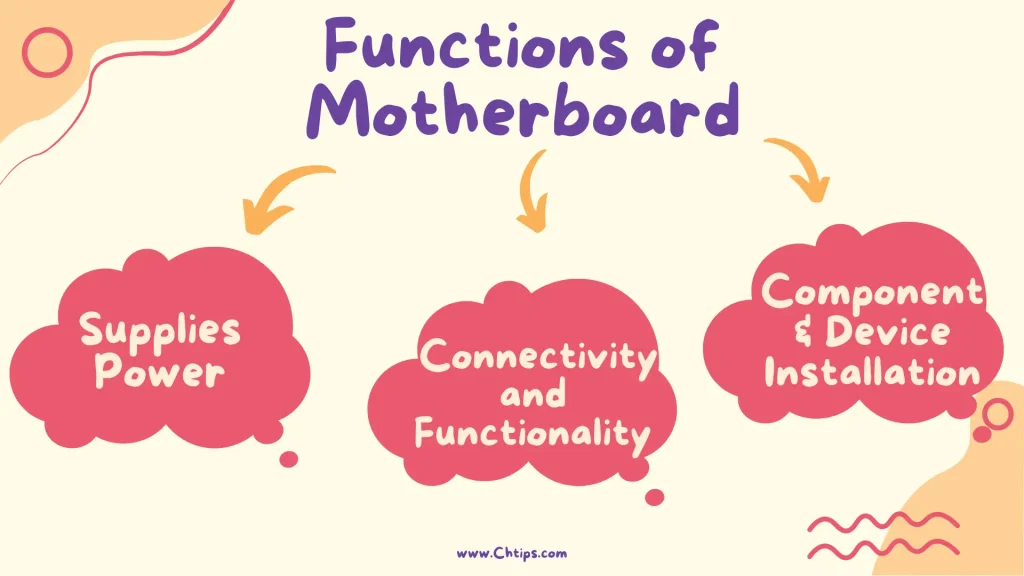
- The computer motherboard supplies power to other components and devices.
- Other important devices can be installed on a computer motherboard.
- Motherboards provide expansion slots for better connectivity and functionality.
Different Types of Motherboards in Computer Systems?
| # | Motherboard Types |
| 1 | AT |
| 2 | ATX [MicroATX] |
| 3 | Baby AT Motherboard |
| 4 | Full ATX |
| 5 | Mini ITX MB |
| 6 | FlexATX |
| 7 | Pico BTX |
| 8 | ITX |
| 9 | LPX |
| 10 | BTX |
What are the 6 Main Parts of a Motherboard?
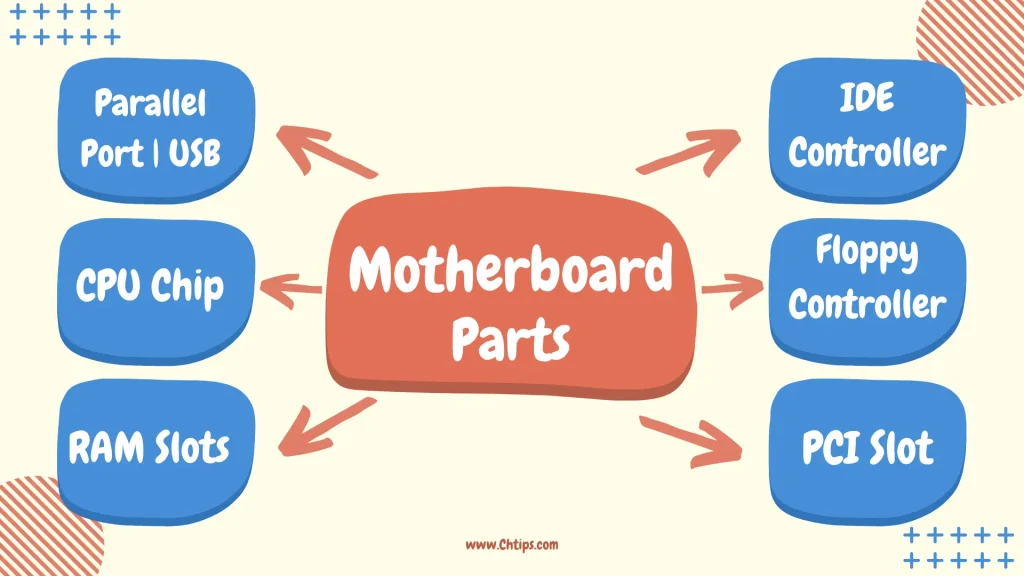
| Parallel Port | USB. |
| CPU Chip. |
| RAM Slots. |
| IDE Controller. |
| Floppy Controller. |
| PCI Slot. |
Importance of Motherboard in Computer System
The computer motherboard is the core and most vital component of any computer system. All the other devices and components can be easily installed on the motherboard.
Some of the devices that are installed on computer motherboard are as mentioned below.
- Central Processing Unit.
- Random Access Memory [RAM].
- Hard Disk Drives [HDD].
- Solid State Drives [SSD].
- DVD RW.
- Mouse.
- Keyboard.
- Printer.
The computer motherboards are compact in shape and size, and hence they can be fitted in small size cabinets usually called “Chassis”.
The size of the motherboard defines how many components can be installed on it.
Therefore, the motherboard is called as the foundation of any computer system.
The computer motherboard is responsible to distribute and supply power to other components and devices received by the power supply [SMPS].
They are usually damaged by electric surges and spikes in voltage disturbance.
The motherboard not only connects other devices together; it also acts as a central hub between the system and the user.
9 Uses of Motherboard in a Computer System
- All the parts and components are attached to the motherboard.
- The motherboard acts as a bridge between the user and other computer devices.
- Motherboard consumes less power.
- The motherboard supports high-end processors and memory.
- A motherboard helps in better communication between devices.
- Data and information can be shared with amazing speed and accuracy.
- CPU is the brain of the computer that is connected to the motherboard.
- Computer motherboards consist of expansion slots and ports that enable devices to connect.
- They are inexpensive and hence widely used in desktops, and laptops.
Top Computer Motherboard Manufacturing Companies.
| # | Company | Launched Date |
| 1 | Intel. | 18 July 1968 |
| 2 | Asus. | 1989 |
| 3 | MSI. | 1986 |
| 4 | Gigabyte Technology. | 1986 |
| 5 | ASRock. | 2002 |
| 6 | Acer Inc. | 1976 |
| 7 | EVGA Corporation. | 1999 |
| 8 | Biostar. | 1986 |
| 9 | American Megatrends. | 1985 |
| 10 | Sapphire Technology. | 2001 |
Frequently Asked Questions [FAQs] on What is A Computer Motherboard
Where is Motherboard Located?
Motherboard is installed in the computer case also called as “Chassis”.
Who Invented Motherboard?
The first motherboard was introduced by IBM in 1981.
What is Another Name for a Motherboard?
mainboard, main circuit board, mb, base board, system board, and logic board.
What is the Father of Motherboard?
IBM Engineer Patty McHugh.
What are the Two Types of Motherboards?
Standard ATX.
Micro ATX.
What is the Original Name of Motherboard?
The first motherboard was called a “planar”.
What is the Biggest Motherboard?
Extended ATX.
What is the Size of the Computer Motherboard?
305 x 244 mm. (12 x 9.6 in).
What are the 3 Types of Motherboards in a Computer?
The three types of motherboards are XT motherboard, AT motherboard, and ATX motherboard.
Get In Touch
I have also written and compiled some articles on computers and telecommunications, and please go through them.
I hope you will like reading it.
All the questions and queries related to What is a Motherboard are answered here.
If you have any questions about the Types Definition Uses and Functions of Motherboard
Don’t hesitate to contact me, and if you feel to add, remove or update anything from the article, please let me know in the comment section or via email.
I will be more than happy to update the article. I am always ready to correct myself.
Please share this article with your friends and colleagues; this motivates me to write more related topics.
!!! Thank You !!!